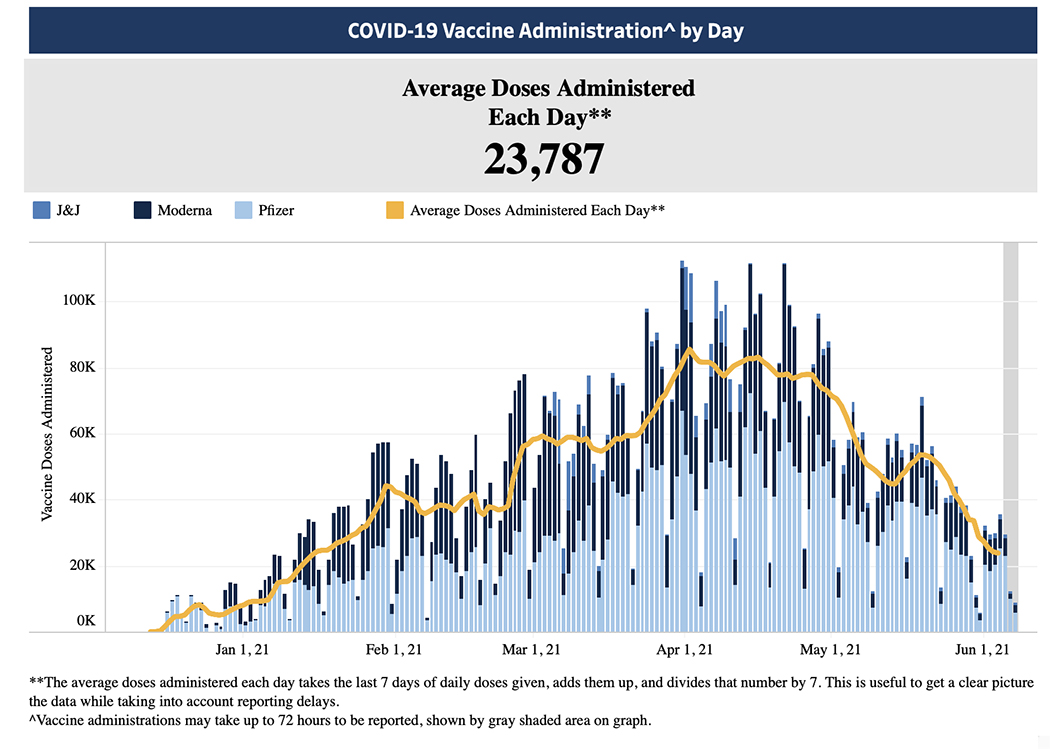In April, the United States began offering the coronavirus vaccine to anyone age 16 and older, and right away millions of people lined up outside stadiums, schools, and other mass vaccination centers, relieved to finally get the life-saving shot.
But now, nearly two months later, vaccination rates have plummeted across the U.S. The country is giving out less than 1 million shots per day, compared to more than 3 million at its April peak, according to the Centers for Disease Control. Many people who want the vaccine have already received it, leaving it up to governments to reach out to the millions still hesitant to get the jab.
In Virginia, the average daily doses administered per day has fallen from 85,000 in April to 23,000 this week, even though 44 percent of the state has yet to receive a single dose.
Since early May, coronavirus cases in the Blue Ridge Health District have been in the single digits, thanks to high vaccination rates and warmer weather. The many people who continue to wear masks in public spaces and practice social distancing—despite Governor Ralph Northam’s lift on all pandemic restrictions—have also helped keep transmission low.
But local vaccinations have slowed down “to some extent,” says health district spokesman Ryan McKay.
“We did see a period where really first-dib appointments for Pfizer and Moderna dropped off,” he says. “We saw a little bit of an uptick when Pfizer was made eligible and approved for 12- to 15-year-olds [on May 12], but then we’ve seen that plateau hitting us here.”
In Albemarle, 55 percent of residents are fully vaccinated. In Charlottesville that number is 48.
However, in other counties in the health district, such as Louisa and Greene, less than 40 percent of the population is fully vaccinated.
“There is hesitancy and uncertainty about the vaccine…so [we need] to give people an opportunity to get educated on the safety and efficacy of the vaccine,” says McKay. “But also we’ve been asking people to come to us to get vaccinated. Those people who really want to go out and get it have done so.”
“Now we need to sort of change that approach, and we need to now go to people,” he says. “We have to be a little more mobile and thoughtful about heading to neighborhoods, going to schools, [and] getting out into the community to provide education and outreach to give people more access and remove some of those barriers.”
BRHD plans to continue to work with community leaders from demographics with lower vaccine rates, particularly Black and Latino communities, and host pop-up vaccine clinics in underserved neighborhoods like Friendship Court and Westhaven.
“You have to rely on those trusted community leaders [to] help with delivering the message,” says McKay. “And to tell their own story about why they got vaccinated and their experience to help get over hesitancy.”
According to census tract records obtained by Charlottesville Tomorrow, predominantly Black neighborhoods in the city like 10th and Page and Fifeville have vaccination rates below 35 percent, while predominantly white neighborhoods like North Downtown and Greenbrier have rates between 55 and 65 percent. To date, around 31 percent of Charlottesville’s white residents are fully vaccinated compared to 24 percent of Black residents. (About one-third of vaccinated people did not report their race.)
The health district has also partnered with UVA Health to send community health workers and vaccinators door-to-door in underserved neighborhoods, allowing residents to voice any questions or concerns they have about the shot and, if they choose to, get it right on the spot. In the near future, the district plans to create a mobile vaccine unit and host additional pop-up clinics at places of employment.
“Through that outreach, we’re really able to convince people that this is a good thing,” says McKay. “And if there are people who want to get vaccinated, but for whatever reason it doesn’t fit into their schedule, we want to try to accommodate that.”
Other states have tried to encourage vaccination by offering prizes to those who get the shot. States like New York and Oregon are offering jab-getters a chance to win millions of dollars in cash or scholarships, while West Virginia is doling out custom rifles, shotguns, and trucks. This week, Washington started giving adults who get the vax pre-rolled joints, on top of incentives like lottery drawings, tickets to sporting events, and gaming systems.
Such drastic measures haven’t been necessary in the health district, says McKay.
“We’re really trying to focus on education and outreach,” he explains. “In Charlottesville and Albemarle we already have some of the highest vaccination percentages in the state…[so] at least for right now we’re not really entertaining the idea of offering incentives.”
The district ultimately hopes to meet President Joe Biden’s goal of having 70 percent of adults receive at least one dose of the vaccine by July 4.
“We need to continue to work on mitigation strategies until we can give everyone access,” says McKay. “There’s still risk, and people who can still get sick, and we just want to be mindful of that as we’re heading into summer.”
